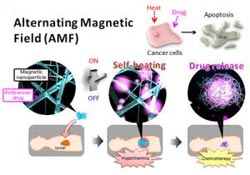Smart anticancer nanofibers: Setting treatments to work together

Design concept for a smart hyperthermia nanofiber system that uses magnetic nanoparticles (MNPs) dispersed in temperature-responsive polymers. Anticancer drug, doxorubicin (DOX), is also incorporated into the nanofibers. The nanofibers are chemically crosslinked. First, the device signal (alternating magnetic field, AMF) is turned 'on' to activate the MNPs in the nanofibers. Then, the MNPs generate heat to collapse the polymer networks in the nanofiber, allowing the 'on-off' release of DOX. Both the generated heat and released DOX induce apoptosis of cancer cells by hyperthermic and chemotherapeutic effects, respectively.<br>
Stimuli-responsive or ‘smart’ polymeric nanofibers have attracted increasing attention. The nanoscale structures give rise to high sensitivity to stimuli while they can also be manipulated easily as macroscopic materials.
Now researchers at the University of Tsukuba and the National Institute of Materials Science in Japan have demonstrated how they can be used to host magnetic nanoparticles to exploit hyperthermal effects for treating cancer while avoiding the usual side-effects. The incorporation of doxorubicin in the nanofibers as well allows controlled release of the anticancer drug as an additional mechanism for killing cancer cells.
Magnetic nanoparticles can kill cancer cells through the heat generated by induction when subjected to an alternating magnetic field. Such hyperthermal treatments have also been shown to improve the efficacy of anticancer drugs. However the nanoparticles can also lead to impaired mitochondrial function, inflammation, and DNA damage. Incorporating the nanoparticles into nanofibers may provide a solution.
Young-Jin Kim , Mitsuhiro Ebara , and Takao Aoyagi electrspun the fibers from a solution of the polymer poly(NIPAAm- co -HMAAm) mixed with a solution of magnetic nanoparticles and doxorubicin. The heating caused by the nanoparticles when switching on an alternating magnetic field caused hyperthermal effects, as well as reversible deswelling and deformation of the fibers, which released the drug molecules. Investigations in vitro and in cell lines demonstrated effective killing of cancer cells, which was greatly reduced for hyperthermal treatments alone in the absence of doxorubicin.
“The doxorubicin/magnetic-nanoparticles nanofi ber induced the apoptosis of cancer cells due to a synergistic effect of chemotherapy and hyperthermia,” say the authors. The work demonstrates how smart nanofibers have potential for use as a manipulative material that combines hyperthermia and drug release treatments that can be controlled with the simple switching on or off of an alternating magnetic field.
Contact information
International Center for Materials Nanoarchitectonics(WPI-MANA)
1-1 Namiki, Tsukuba-shi Ibaraki, 305-0044 Japan
Email: Jonathan.Hillnims.go.jp and ARIGA.Katsuhikonims.go.jp
Telephone: +81-29-860-3354
Journal information
Reference
A smart hyperthermia nanofi ber with switchable drug release for inducing cancer apoptosis Young-Jin Kim1,2, Mitsuhiro Ebara1 , and Takao Aoyagi1,2 *,2013 Adv. Funct. Mater. doi: 10.1002/adfm.201300746 .
Affiliations
1. Materials and Science Engineering Graduate School of Pure and Applied Science University of Tsukuba 1-1-1 Tennodai, Tsukuba, Ibaraki 305-8577, Japan
2. Biomaterials Unit International Center for Materials Nanoarchitectonics (WPI-MANA) National Institute for Materials Science (NIMS) 1-1 Namiki, Tsukuba, Ibaraki 305-0044, Japan
*Corresponding author: AOYAGI.Takao@nims.go.jp
Media Contact
More Information:
http://www.nims.go.jp/mana/All latest news from the category: Materials Sciences
Materials management deals with the research, development, manufacturing and processing of raw and industrial materials. Key aspects here are biological and medical issues, which play an increasingly important role in this field.
innovations-report offers in-depth articles related to the development and application of materials and the structure and properties of new materials.
Newest articles

Superradiant atoms could push the boundaries of how precisely time can be measured
Superradiant atoms can help us measure time more precisely than ever. In a new study, researchers from the University of Copenhagen present a new method for measuring the time interval,…

Ion thermoelectric conversion devices for near room temperature
The electrode sheet of the thermoelectric device consists of ionic hydrogel, which is sandwiched between the electrodes to form, and the Prussian blue on the electrode undergoes a redox reaction…

Zap Energy achieves 37-million-degree temperatures in a compact device
New publication reports record electron temperatures for a small-scale, sheared-flow-stabilized Z-pinch fusion device. In the nine decades since humans first produced fusion reactions, only a few fusion technologies have demonstrated…





















